The Northeast’s alpine climb for the everyman, Henderson Ridge offers stellar rock climbing in an incredible setting.
With 200+ meters of climbing, followed by another several hundred feet of scrambling, Henderson Ridge is perhaps the best easy alpine climb in New Hampshire. Located on the northern side of Mount Washington’s Huntington Ravine and climbing the prominent ridge of rock just above North Gully, Henderson Ridge is best enjoyed on a clear summer or early fall day. Between the stellar position and the fantastic climbing, it should be on every Northeast climber’s to-do list.
Quick Facts
Time to complete: 1 day
Difficulty: ★★★
Scenery: ★★★★
Henderson Ridge History
Henderson Ridge was first climbed by Kenneth Henderson, Miriam O’Brien, John Hurd, Jr., and Marjorie Hurd on May 30, 1927, as part of the first White Mountain climbing trip sponsored by the Appalachian Mountain Club. In the book, Rock Climbs in the White Mountains of New Hampshire, Ed Webster reports that Henderson filmed a movie documenting the first ascent.
According to Webster, two teams of climbers (Kurt Winkler, Alain Comeau, Jim Surette, and Randy Rackliff) put this Grade III route back on the radar of modern climbers when they “rediscovered” it in December 1985.

Getting There
Parking for the traditional approach to Henderson Ridge is at the AMC’s Pinkham Notch Visitor Center in Gorham, just north of Jackson on Route 16. For those using a vehicle assist on the approach, drive a bit further north on Route 16 to the Mount Washington Auto Road.
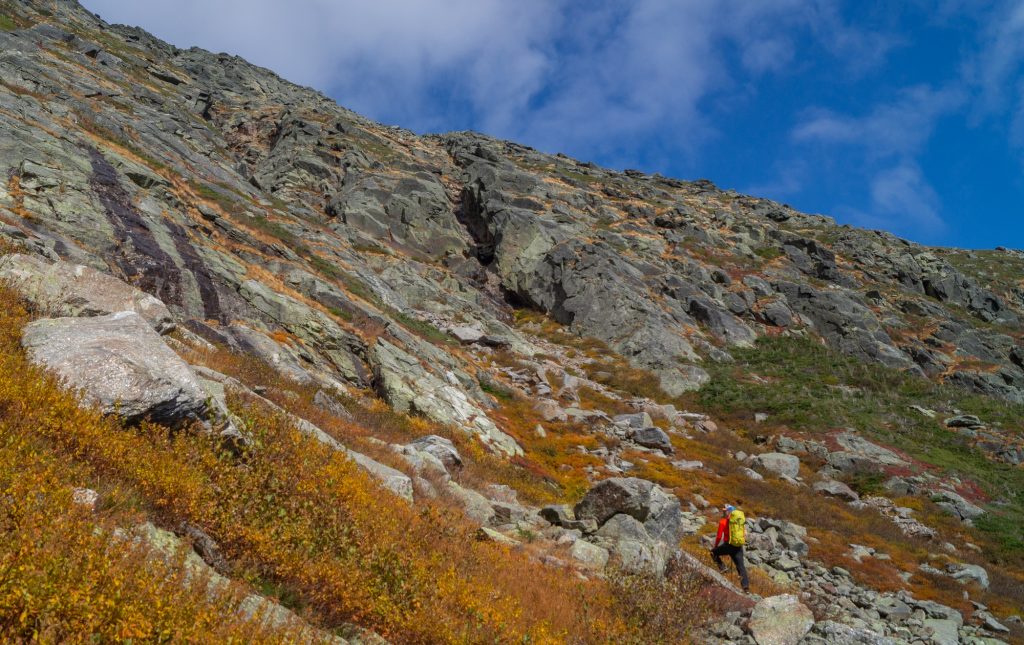
The Approach
There’s no easy way to get to Henderson Ridge. The traditional way is to approach from Pinkham Notch, taking the Tuckerman Ravine Trail, the Huntington Ravine Fire Road, and the Huntington Ravine Trail (HRT) to a sometimes-visible herd path that traverses to the base of Henderson Ridge at the bottom of North Gully.
Located at almost the same elevation as the broad platform at the base of North Gully, the herd path can be hard to find along the HRT. One terrain clue: it’s after the HRT comes out of the trees, briefly ascends left-to-right across an open talus slide, and then starts climbing left again. Even with the best beta, the herd path usually feels a bit bushwhacky (especially at the start) and isn’t the most fun 20-25 minutes. Between the hiking and bushwhacking, expect the approach to take 2 to 2.5 hours.
A possible shortcut: drive up the Mount Washington Auto Road and then descend via the HRT to the herd path. This saves several miles of hiking and 2,000+ feet of elevation gain, but it increases your exposure due to the difficulties of descending the HRT on foot. It’s also expensive. It can cost as much as $45 for a car and driver, plus an additional $20 per passenger. If you do take this option, you’ll quickly see why the Appalachian Mountain Club’s White Mountain Trail Guide does not recommend descending the HRT. In a few locations, expect to deploy your climbing rope to maintain a margin of safety.

The Climbing
Rope up at the broad platform below North Gully, then begin climbing the spine of the ridge that tracks up the right side of the gully. For the first 70-ish meters, the climb stays almost on the ridge proper. The climbing through here is quite consistent, with almost every move feeling about “5.fun.” It’s also possible to ascend the slabby sections out to the right of the ridge. This feels a little easier, however, there are fewer gear options here.
At about 60-70m (i.e., near the top of the first pitch if you’re using a longer rope) there are a few short steps. Two of these steps have reasonable spots for gear anchors, the first in the vertical crack that ascends the step and the second in cracks on the right side of the wall above the step. The latter offers the better stance but is also a bit more than a single rope length from the start of the climb.
Whichever anchor you choose, the climb from here on out ascends a series of rock steps, each section about 30 to 40 meters. Each steep section has some fun climbing, followed by some very easy scrambling to the base of the next step. Although it’s possible to link the steps together with a longer rope, it can easily lead to a lot of rope drag and difficult communication. Assuming you are pitching it out, it’s often just as effective to climb shorter pitches and build solid gear anchors at the base of the steps.

Just below the last step, a diving board of rock juts out over the open expanse of North Gully below. It’s an exhilarating position that makes for a great picture, especially if you get Pinnacle Buttress (home to the super-classic Northeast Ridge of the Pinnacle) and Pinnacle Gully in the background.
After you snap some pics, ascend the step—this one, like the one before, is a right-trending open book—and continue up broken terrain, building an anchor around one of the many boulders. Although this marks the end of the pitched climbing, there’s still a fair amount of scrambling to go.
All told, there are about 220 meters of pitched climbing on Henderson. And depending on how you break up the pitches, this equates to somewhere between four and eight pitches.

The Scrambling
After the pitched climbing, follow a small herd path near the edge of the ridge proper as it weaves its way toward the rim of Huntington Ravine. As the herd path peters out, you’ll need to scramble through some additional short steps. Depending on your route finding, sometimes these steps can feel tricky, so it’s usually a good idea to keep your harness on and the rope accessible. This is especially true if your party lacks experience in fourth-class terrain.
Eventually the scrambling transitions to talus climbing and then rock hopping before finally topping out on the rim of Huntington Ravine. Here you’ll intersect with the Nelson Crag Trail, with options to continue on to the summit of Mount Washington or descend back to Pinkham Notch.
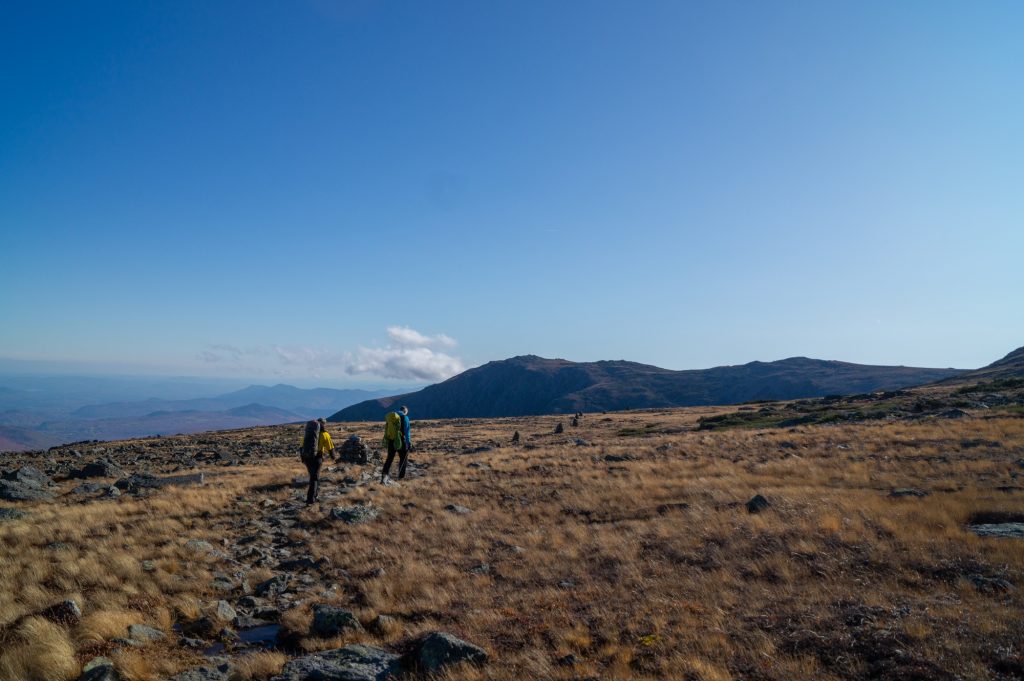
The Descent
To descend to Pinkham Notch, follow the Nelson Crag Trail (NCT) uphill to its junction with the Alpine Garden Trail (AGT). Take the AGT south (i.e., left and away from the Auto Road) to its junction with the Lion Head Trail. Descend via the Lion Head Trail, eventually joining the Tuckerman Ravine Trail on its way to Pinkham Notch. Expect the descent to take 2+ hours.
If you’ve somehow managed to spot a car on the Mount Washington Auto Road (or you are up for hitchhiking) the road is easily accessed by turning right at the junction of the NCT and AGT.
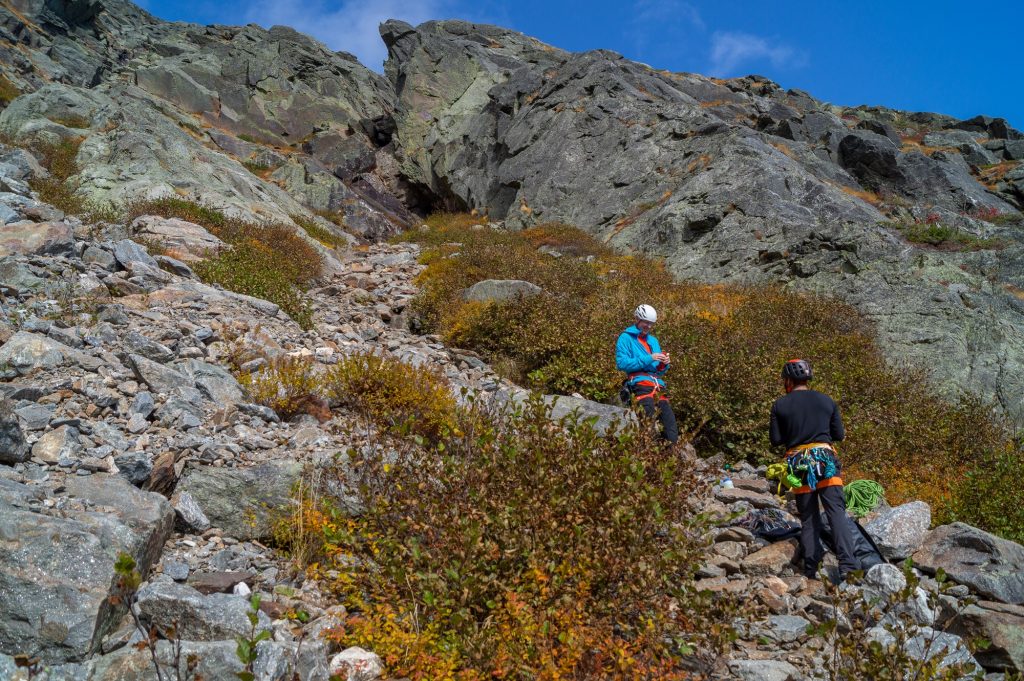
The Kit for Climbing Henderson Ridge
Light is right on Henderson Ridge. If you have a good weather window and you’re looking to move efficiently, here are a few tips for trimming your kit.
- Hauling a full-length rope, regular harness, and large rack up to Henderson Ridge is definitely going to be heavy. Cut some weight by using a shorter rope, an alpine harness like the Black Diamond Couloir LT, and a small alpine rack.
- Those comfortable with Henderson Ridge’s grade may want to leave the climbing shoes behind and opt for a pair of approach shoes like the Black Diamond Mission LT (men’s/women’s) for both hiking and climbing.
- Because carrying water for that long of a day can be overwhelming, consider carrying a small water filter so you can bring just a single bottle, refilling it in the numerous streams along the way. A Sawyer Mini Water Filter works great and takes up little space in your pack.
- Carrying an insulating layer is always a wise idea when recreating on Mount Washington—especially on Henderson Ridge, where you’re a long way from help. The Outdoor Research Helium Down Hooded Jacket (men’s/women’s) should keep you plenty warm and packs sufficiently small.
- Trekking poles are wonderful for the rocky approach and descent. A collapsible pole like the Black Diamond Distance Carbon FLZ Poles will fit inside your pack while you’re sending the route.
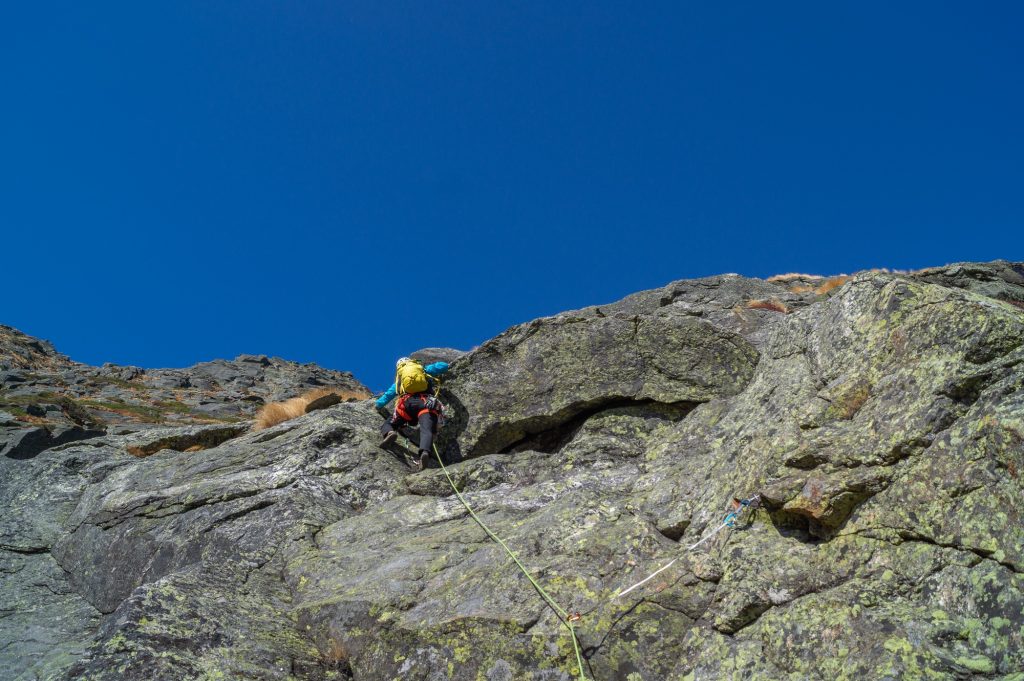
Keys to Climbing Henderson Ridge
- There are no bolted anchors on Henderson Ridge. So if you want to move efficiently, get your gear anchors dialed.
- It’s often windy in the ravine, and between the wind and the stepped nature of the route, communicating with your partners can be challenging. Radios allow for necessary conversation.
- There’s a reason Mount Washington has earned the reputation as “home of the world’s worst weather.” Before you head out, consult the Mount Washington Observatory’s Higher Summits Forecast, and if the weather isn’t in your favor, consider another climbing objective, like Standard Route on Whitehorse Ledge, Lost in the Sun on the Webster Slabs, or Upper Refuse on Cathedral.
- Climbing Henderson Ridge is a big day. Replenish all the calories you burned at the Moat Smokehouse and Brewing Company—a long-time staple of local and visiting climbers alike.
- Forget a key piece of climbing gear at home or just want to check out the latest and greatest outdoor stuff? EMS’s conveniently located North Conway store has you covered.
Current Conditions
Have you recently climbed Henderson Ridge? What did you think? Share your favorite parts in the comments!
Tim Peck and Doug Martland
Tim and Doug met long ago at the Eastern Mountain Sports in Canton, Massachusetts. Bonding over a love of slick Quincy Quarry granite, White Mountain sufferfests, and scheming up adventures while folding tee-shirts, today Tim and Doug collaborate to write about their favorite outdoor activities and occasionally get nostalgic about tee-shirt tables.
Related Posts
April 12, 2024
Explore Like a Local: The Outdoor Mecca of North Conway, NH
There's a lot to love about this New…
April 3, 2024
5 Things To Do in the Boston Area During Mud Season
Adventure opportunities are abundant…
1 Comment
Comments are closed.





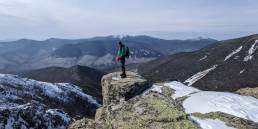
[…] a moment to soak up the fantastic view, with the Wildcats and Carters stretched out before you and Henderson Ridge to your […]